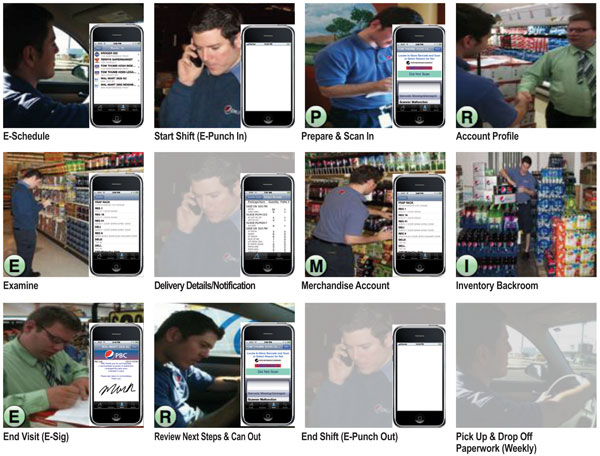News
PepsiCo Modernizes Beverage DSD Route System With Custom iOS Apps
February 11, 2015
TAGS: Pepsico, Raymond Brown, Mark Uppaluri, PepsiCo North America Beverages, beverage route management app, Customer Engagement Technology World, direct store delivery, DSD model, Power4Merch, Planogram |
NEW YORK CITY -- PepsiCo North America Beverages has developed a custom app for iPhones and iPads that's made distribution and merchandising faster and simpler for its managers and field staff. Sharing the details of the technological leap at the recent Customer Engagement Technology World trade show at New York City's Jacob K. Javits Convention Center were PepsiCo's Raymond Brown and Mark Uppaluri. While the needs and circumstances of vending route personnel differ from those of direct-store delivery drivers, Brown and Uppaluri's overview of designing a mobile application for DSD routes could be of great interest to some in the vending business.
 |
Raymond Brown |
"They were all mom and pops with one salesperson serving them up and down the streets," he recalled. "Through consolidation they became supermarket chains. And the rise of mass merchandisers brought another big change in retail."
These shifts in the retail landscape put pressure on PepsiCo to find new ways to help stores remain competitive and continue to draw consumers. The Purchase, NY-based beverage giant rose to the challenge by innovating its packaging, expanding its beverage portfolio, creating marketing programs to support these initiatives and changing its service structure.
Brown noted that in the "old days" of its route service model, each driver sold and delivered and had a one-on-one relationship with each store owner. But as the environment grew more complex, PepsiCo responded by developing a pre-sell system.
That system divides and specializes labor by assigning each employee in the field to the single task of selling, dispatching, delivering or merchandising. While the change to the presell system improved productivity and gave field personnel the ability to serve the customer more effectively and efficiently, it has also had its shortcomings.
"We could add and remove routes as needed and gained a lot of efficiency, but there are a lot of moving parts and in some ways it was very uncoordinated," recalled Brown. "Merchandising was all on paper, with ad hoc management; employees drove their personal vehicles to the stores they served and called their managers to say if they were on or off the clock."
PepsiCo's answer was to invest in technology. "Now it's all connected and workers and managers have visibility," Brown said.
He likened PepsiCo's development of its apps to creating an "assembly line" for a virtual team. "Like Henry Ford, we can now coordinate, synchronize and specialize functions," he said. "PepsiCo has tailored activities by channel, leveraging specialization and functional expertise. How do you optimize a virtual team separated by time and space? How do you support, intervene, control and foster collaboration? Henry Ford could sit and look and see if there's an issue."
 |
Mark Uppaluri |
The tech expert said developing the custom app for field personnel -- called Power4Merch -- was a straightforward process. It took only four months from start to finish to deliver a production-ready application.
In North America, PepsiCo runs about 17,000 routes a day. It has to get products from its manufacturing and warehouse facilities onto its trucks and into stores in time to meet demand. By using iPhones and iPads at every step along the way, it has become far more efficient and can get in front of problems before they happen.
A Day In the Life Of Merchandisers
How smartphone-guided process transforms nonvalue tasks

"It allows a merchandiser to see his plan for the day right on the iPhone," said Uppaluri. "It has an electronic timecard, and he can see his schedule, the store details, the account profiles, and everything he needs to know to service the store."
In the past, PepsiCo drivers and merchandisers began each day by picking up printed schedules with order quantities and tasks to be performed at each store, from unloading cases of soda to setting up new product displays. If a store needed to add to or cancel an order, it was a challenge to accommodate the request on the fly because communicating with the delivery drivers was difficult.
Managers now use iPads to monitor their teams' performance, pull up pricing, planograms and contracts, and help coordinate deliveries with merchandising using two custom apps for iPad.
The Manager's Briefcase app gives territory sales managers electronic versions of all the paperwork and resources they need to manage their teams, including store audits, employee coaching forms and automated notifications to merchandisers.
The manager's iPad automatically sends a "push" notification to the merchandiser's iPhone if he has a new stop, for example. Instead of checking emails and paperwork in the office, the manager starts and ends his day wherever he needs to be while virtually connected to his team.
The second app, SPOTLight, gives managers instant access to pricing, display planograms, contracts and more.
And iPhone and iPad fit in with PepsiCo's established IT systems, which Uppaluri said simplified deployment and security. PepsiCo used Mobile Device Management from AirWatch to securely deploy and manage its applications. The beverage giant leverages the built-in security on iPhone and iPad to protect the devices from unauthorized access.
PepsiCo supplies the Apple smartphones and tablets to its mobile salespeople, merchandisers and managers, which they can use as they wish within company guidelines for their personal use.
"We made the decision that it would not be a purpose-built device," Uppaluri said. "That meant we'd let them use it for both their personal use and for the Pepsi enterprise. The can put their own music, contacts and apps on it. We left it wide open and having that perk was another reason for employees to be on board."
PepsiCo's millennials immediately took to the technology, but getting their older cohorts to adapt was a bit of a challenge. "Many people were more comfortable with pencil and paper. So we leveraged the millennials to help their less tech-savvy peers," Brown said. "We knew they'd help fill in when needed in helping transition."
He said PepsiCo first tested a proof of concept of its apps in a limited pilot and then conducted a scaled market test that helped identify the trouble spots in its functionality before rolling the technology out systemwide.
"In the early days, the longest part was to implement the idea. We had a four to six month incubation period to hash it out and work it through," Brown observed. "After that, the code and apps were really quick and the learning from users was immediate. We tend to add to and remove functions three times a year. It's an over-the-air system, so we can do it easily and quickly."
Uppaluri noted that the gains in operational efficiency of the company's DSD system have been pronounced with the iPhones and iPads facilitating real-time communication, leveraging data and eliminating the need for printed information such as schedules and order quantities.
Brown said plans are in the works to leverage similar technology in other parts of PepsiCo's supply chain. He didn't specify whether vending might be included.
Editor's Note: Raymond V. Brown Jr. is a senior director in PepsiCo's Go To Market System. Mark Uppaluri, formerly a director in PepsiCo's Go To Market System, is now the senior director of strategy at Infinite Peripherals.


